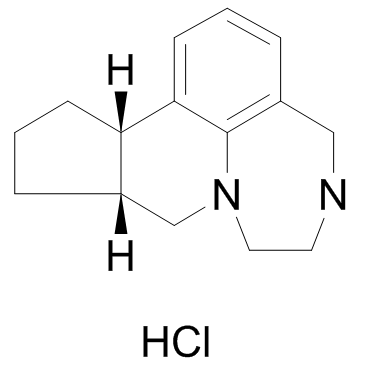Vabicaserin hydrochloride (SCA 136) (Synonyms: SCA 136) |
| Catalog No.GC30964 |
Vabicaserin hydrochloride (SCA 136) is a 5-hydroxytryptamine 2C (5-HT2C) receptor-selective agonist with an EC50 of 8 nM.
Products are for research use only. Not for human use. We do not sell to patients.

Cas No.: 887258-94-8
Sample solution is provided at 25 µL, 10mM.
Vabicaserin hydrochloride is a 5-hydroxytryptamine 2C (5-HT2C) receptor-selective agonist with an EC50 of 8 nM.
Vabicaserin displaces 125I-(2,5-dimethoxy)phenylisopropylamine binding from human 5-HT2C receptor sites in Chinese hamster ovary cell membranes with a Ki value of 3 nM and is >50-fold selective over a number of serotonergic, noradrenergic, and dopaminergic receptors. Binding affinity determined for the human 5-HT2B receptor subtype using [3H]5HT is 14 nM. Vabicaserin is a potent and full agonist (EC50, 8 nM; Emax, 100%) in stimulating 5-HT2C receptor-coupled calcium mobilization and exhibits 5-HT2A receptor antagonism and 5-HT2B antagonist or partial agonist activity in transfected cells, depending on the level of receptor expression. Vabicaserin exhibits lower affinity at the 5-HT2C antagonist binding site (22 nM) labeled with [3H]mesulergine. Additional binding studies indicate that Vabicaserin possesses affinity for the 5-HT2B and 5-HT1A receptors with Ki values of 14 and 112 nM, respectively[1].
After a single oral dose of [14C]Vabicaserin at 50, 5, and 15 mg/kg, unchanged drug represents less than 19, 20, and 35% of total plasma radioactivity at all the time points examined in mice, rats, and dogs, respectively. The carbamoyl glucuronide (CG) represents approximately 7 to 36% of plasma radioactivity in mice and 2 to 28% of plasma radioactivity in dogs but is not detected in rat plasma after the single [14C]Vabicaserin dose. However, the CG is observed in rat plasma after multiple-dose administration of Vabicaserin at higher doses, and the CG is approximately 20 times less than Vabicaserin based on steady-state AUC0-24 values. The estimated plasma AUC0-24 ratios of CG to the parent drug are 1.5 and 1.7 in mice and dogs after the single [14C]Vabicaserin dose, respectively. The plasma AUC0-24 ratios for the CG to Vabicaserin at steady state with doses used for safety assessment are less for mice (0.2-0.6) and slightly higher for dogs (1.8-4.0) compared with the single dose values. The CG is detected in dog urine in similar amounts to the parent drug, although it is not detected in mouse or rat urine after the single [14C]Vabicaserin dose. Radioactivity in a 0- to 24-h bile collection from rats receiving a 5 mg/kg [14C]Vabicaserin dose accounts for 19 and 24% of the administered dose in males and females, respectively. Although the CG is not detected in urine or feces of rats after a single oral administration, it represents an average of up to 30% of biliary radioactivity in male rats and 15% in female rats. In monkeys after a single oral 25-mg/kg dose of Vabicaserin, the plasma concentrations of the CG exceeded those of Vabicaserin at all the time points (2-24 h) postdose, although the amount of CG relative to Vabicaserin decreased by 24 h postdose, with ratios of 17.5 at 2 h and 1.7 at 24 h. The CG to Vabicaserin AUC0-24 ratio of 12:1 indicates that the CG is a major metabolite in monkeys[2].
[1]. Dunlop J, et al. Characterization of Vabicaserin (SCA-136), a selective 5-hydroxytryptamine 2C receptor agonist. J Pharmacol Exp Ther. 2011 Jun;337(3):673-80. [2]. Tong Z, et al. Species differences in the formation of Vabicaserin carbamoyl glucuronide. Drug Metab Dispos. 2010 Apr;38(4):581-90.
Average Rating: 5 (Based on Reviews and 22 reference(s) in Google Scholar.)
GLPBIO products are for RESEARCH USE ONLY. Please make sure your review or question is research based.
Required fields are marked with *




















